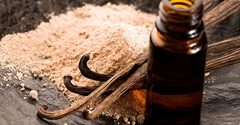Vanilla and Natural Product Testing – Why Does It Matter?
As consumers place growing importance on “natural” ingredients, there are increasing instances of synthetic alternatives, which are often cheaper, being used in place of the more expensive naturally sourced products. Alongside this trend is a growing concern among consumers regarding the use of petroleum-sourced synthetic materials. Vanilla, which is extremely popular in the flavor and fragrance industry, is one of the ingredients affected.
Most of the prominent flavor of vanilla comes from the compound vanillin. It is naturally sourced from vanilla orchids, which are in short supply. As a result, the demand for vanillin far exceeds the natural supply and synthetic routes to vanillin have filled the gap.
Currently, the majority of vanillin is produced synthetically; two major routes are using lignin and using guaiacol. Lignin is a byproduct of the paper-making industry while guaiacol is a petrochemical precursor. Being able to verify that a vanillin product is petrochemical-free holds important value for both the distributors and consumers.
Natural Product Analysis of Vanillin Using Carbon-14
 Radiocarbon (Carbon-14) testing can be used for authentication where there is concern that a natural product may have been substituted or adulterated with a cheaper petrochemical synthetic alternative.
Radiocarbon (Carbon-14) testing can be used for authentication where there is concern that a natural product may have been substituted or adulterated with a cheaper petrochemical synthetic alternative.
Carbon-14 analysis distinguishes between the plant-based “natural” and petrochemical sources on the basis of their Carbon-14 content. If sourced from nature, a material has a known Carbon-14 content, whereas a petrochemically sourced material will not contain any Carbon-14. By measuring the Carbon-14 content, it is therefore clear if a natural product has been substituted either wholly or in part with a petroleum-sourced synthetic alternative.
In the case of vanillin, Carbon-14 testing is able to detect the presence of any petrochemically produced vanillin from guaiacol. Given the extent of vanillin produced by guaiacol, being able to differentiate between the plant-based and petrochemical-sourced vanillin is an important tool for many reasons, foremost of which are quality control and marketing. Carbon-14 analysis is not able to distinguish between different plant-based sources of vanillin, for example between vanillin from vanilla orchids and vanillin from lignin.
Beta Analytic – A Natural Products Laboratory
ISO/IEC 17025:2017-accredited Beta Analytic provides fast and high-quality radiocarbon analysis for the fragrance and flavor industry. The results are reported according to either ASTM D6866 or ISO 16620-2 8.3.2: biobased content as a fraction of total carbon (TC) or total organic carbon (TOC). Based in Miami, Florida, the lab provides results accessible online 24/7 along with QA reports. For rates and turnaround time inquiries, please contact Beta Analytic or call a local forwarding office.
References:
MM Bomgardner. 2016. The problem with vanilla: After vowing to go natural, food brands face a shortage of the favored flavor. Chemical and Engineering News 94(36): 38-42.
Greener Industry. n.d. Vanillin: Production Methods Summary. Available at http://www.greener-industry.org.uk/pages/vanillin/4Vanillin_PMS.htm (accessed June 2017).
NJ Gallage and BL Møller. 2015. Vanillin–Bioconversion and Bioengineering of the Most Popular Plant Flavor and Its De Novo Biosynthesis in the Vanilla Orchid. Molecular Plant 8: 40-57.
This entry was posted on Thursday, June 29th, 2017 and is filed under Flavor & Fragrance, Flavors Carbon-14 Analysis, Natural Product Testing .